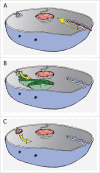Shared mechanisms in physiological and pathological nucleoplasmic reticulum formation
- PMID: 27797635
- PMCID: PMC5287099
- DOI: 10.1080/19491034.2016.1252893
Shared mechanisms in physiological and pathological nucleoplasmic reticulum formation
Abstract
The mammalian nuclear envelope (NE) can develop complex dynamic membrane-bounded invaginations in response to both physiological and pathological stimuli. Since the formation of these nucleoplasmic reticulum (NR) structures can occur during interphase, without mitotic NE breakdown and reassembly, some other mechanism must drive their development. Here we consider models for deformation of the interphase NE, together with the evidence for their potential roles in NR formation.
Keywords: NE; NR; chromosome territories; cytoskeleton; gene expression; membrane curvature; nuclear envelope; nucleoplasmic reticulum.
Figures


References
-
- Prunuske AJ, Ullman KS. The nuclear envelope: form and reformation. Curr Opin Cell Biol 2006; 18:108-16; PMID:16364623; http://dx.doi.org/10.1016/j.ceb.2005.12.004 - DOI - PMC - PubMed
-
- Kamei H. Relationship of nuclear invaginations to perinuclear rings composed of intermediate filaments in MIA PaCa-2 and some other cells. Cell Structure Function 1994; 19:123-32; PMID:7954871; http://dx.doi.org/10.1247/csf.19.123 - DOI - PubMed
-
- Malhas A, Goulbourne C, Vaux DJ. The nucleoplasmic reticulum: form and function. Trends Cell Biol 2011; 21:362-73; PMID:21514163; http://dx.doi.org/10.1016/j.tcb.2011.03.008 - DOI - PubMed
-
- Echevarria W, Leite MF, Guerra MT, Zipfel WR, Nathanson MH. Regulation of calcium signals in the nucleus by a nucleoplasmic reticulum. Nat Cell Biol 2003; 5:440-6; PMID:12717445; http://dx.doi.org/10.1038/ncb980 - DOI - PMC - PubMed
-
- Fricker M, Hollinshead M, White N, Vaux D. Interphase nuclei of many mammalian cell types contain deep, dynamic, tubular membrane-bound invaginations of the nuclear envelope. J Cell Biol 1997; 136:531-44; PMID:9024685; http://dx.doi.org/10.1083/jcb.136.3.531 - DOI - PMC - PubMed
Publication types
MeSH terms
Substances
Grants and funding
LinkOut - more resources
Full Text Sources
Other Literature Sources
